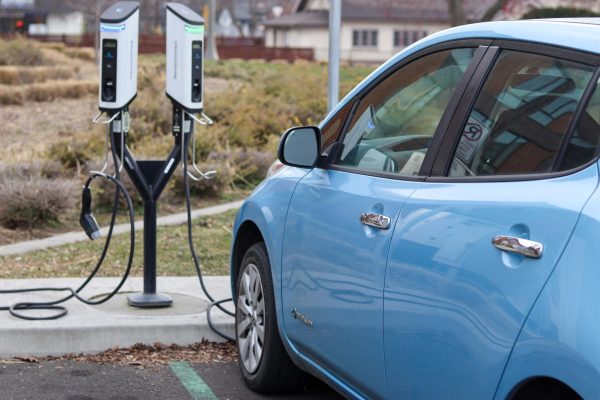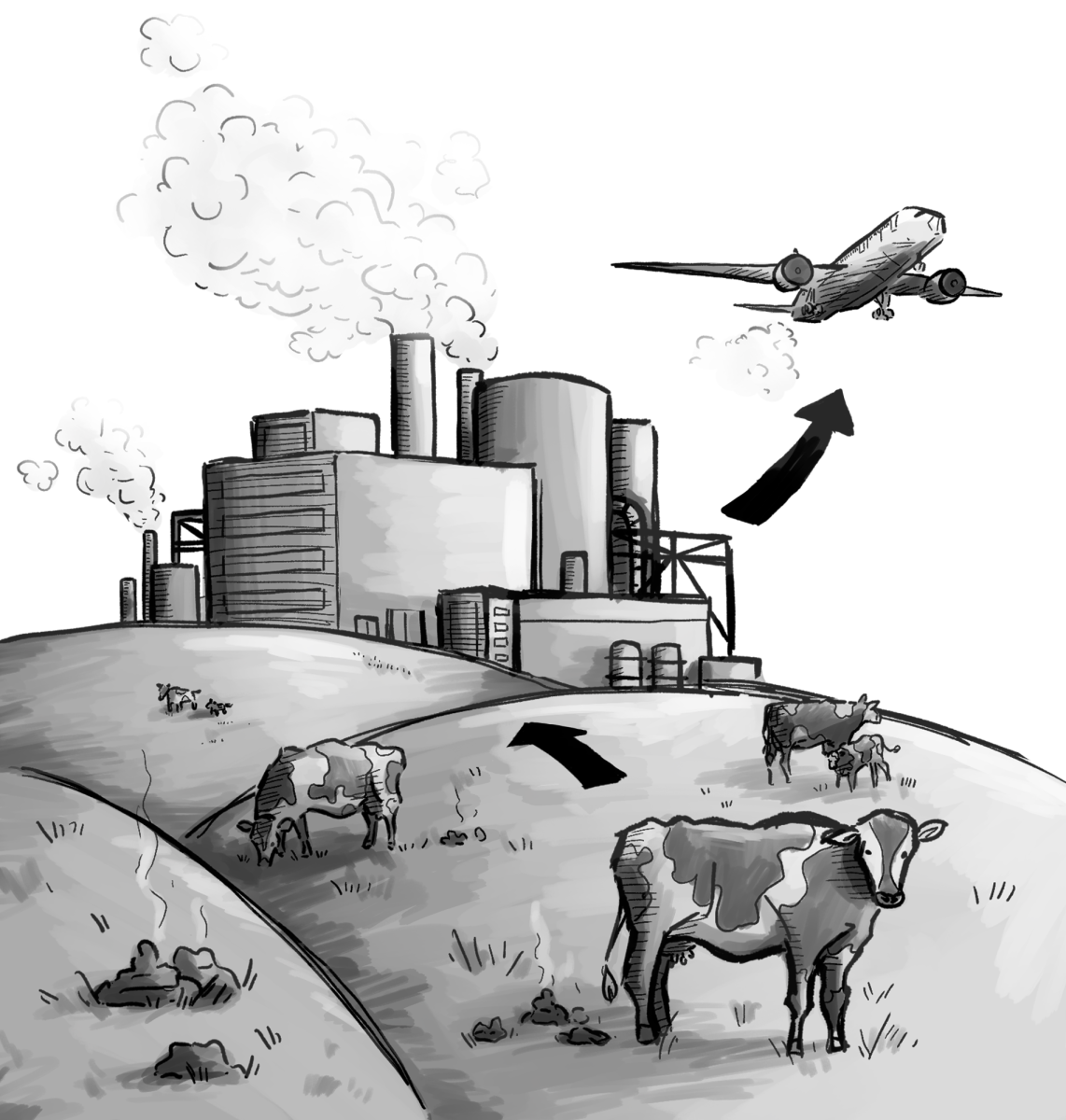
On Dec. 16, 2024, Associated Students of Whitman College (ASWC) announced that two electric vehicles (EVs) will soon be available on campus for students to rent by the hour.
Co-Chair of the ASWC Sustainability Committee Valentina Garcia-Charles explained that the project came about due to a combination of student interest and sustainability goals.
“Jeff Hamrick, who’s the vice president of finance and administration … was getting a lot of emails from students wanting some kind of transportation that Whitman can offer,” Garcia-Charles said.
She explained that Whitman’s sustainability plan requires all new vehicles purchased by the college to be electric.
This policy coincides with former Governor Inslee’s 2021 executive order requiring state agencies to reduce greenhouse gas emissions, in part by replacing older gas-powered vehicles with EVs.
In 2022, the Washington state legislature raised the bar for the electric vehicle (EV) transition. Lawmakers set a goal for all passenger vehicles sold and registered in the state to be electric by 2030, a full five years ahead of California and Oregon’s goals.
This ambitious aim was set as a part of the Move Ahead Washington Transportation Package, which included funding for projects relating to highway expansion, pedestrian safety, public transportation, speed ticket cameras and bicycle education. The package also created the Electric Vehicle Coordinating Council (EVCC), made up of members drawn from 10 different state agencies whose primary responsibility is to turn the 2030 EV objective into reality.
In the nearly three years since its establishment, the EVCC has coordinated tax incentives and rebates on EV purchases and expanded charging infrastructure with the help of the Inflation Reduction Act.
However, just over two weeks ago President Trump signed an executive order, “Unleashing American Energy,” to end the federal exemption that permitted states like Washington and California to mandate the phase-out of gas-powered vehicles. He also pulled federal funding from the Inflation Reduction Act earmarked for EV charging stations.
EV advocates have been highly critical of Trump’s actions, which could not only throw a wrench in individual states’ EV transition timelines, but may also limit the country’s ability to compete in the global EV market.
Trump may be pulling the plug on EV subsidies, but some are skeptical that Trump actually has the power to reverse the country’s course on EVs. Just a few days ago, Trump’s new right-hand-man, Tesla CEO Elon Musk, said the rise in EVs “can’t be stopped.”
A 2024 study by Stanford economists found that although the Inflation Reduction Act’s EV tax credits, which may be revoked by Trump, decreased carbon emissions and boosted American automakers, 75% of the EV subsidies went to buyers who would have purchased an EV regardless of the tax credit.
These findings highlight the potential for economic disparities in the EV transition, as gas-powered vehicles remain significantly less expensive than their electric counterparts, at least for the time being.
I discussed this concern with Whitman Assistant Professor of Economics Wisnu Sugiarto.
“We have to be careful whether the subsidies are enough to help the less affluent people buy a car,” Sugiarto said.
Sugiarto suggested states consider subsidies that help people pay for the maintenance of EVs rather than just the upfront cost.
“Maybe there are less maintenances in the short-run, in the first few years because you don’t need fuel and all that, but maybe after X amount of years, as you need to replace the battery and so on, there [could be] other incentives to help people who have less money to maintain their cars,” Sugiarto said.
As Sugiarto and I discussed the implications of a mass EV transition, it became clear just how much this push is already shaping foreign and domestic policy.
Biden’s Inflation Reduction Act and Infrastructure Investment and Jobs Act allocated $83 billion to support the production of EVs, batteries and charging stations. The Washington State Department of Commerce invested $45 million for consumer rebates on EV purchases and $100 million in grants for installing EV charging stations.
But financial investment is just a fraction of the true cost. The rechargeable batteries used in EVs require valuable minerals like lithium and cobalt. As EVs have become more widespread across parts of North America, Europe and Asia, the market for these minerals has exploded.
Assistant Professor of Politics Denise Fernandes further explained the global implications of an EV transition.
“There’s an imperialistic trend we’re seeing globally with the so-called super powers… we see them all racing toward critical sites to feed the EV boom,” Fernandes said.
Fernandes pointed to Trump’s interest in purchasing Greenland as one manifestation of the scramble to gain control of valuable minerals.
I asked Fernandes if she agrees with the claim that wars for oil will simply be replaced by wars for lithium, cobalt and other precious minerals as EVs take over the market.
“Whether it will actually be a full blown out war like what we have in the Middle East with militaries marching in to protect resources, I think that’s a question mark for us to keep watching,” Fernandes said. “But what we are already seeing is… economic warfare. You have a sanction or you have a tariff barrier or something of that sort being implemented by different countries.”
Sugiarto provided another example that highlights the reality of mineral extraction.
“Right now there’s a war going on in the Democratic Republic of the Congo… and part of the conflict has been triggered by the mineral cobalt,” Sugiarto said. “The mineral is one of the primary ingredients in batteries, so there has been a lot of interest in that region because it’s a money making mineral.”
Approximately two-thirds of the world’s cobalt comes from the DRC, where miners are subjected to subhuman working conditions for just a few dollars per day.
Though many of the worst examples of human exploitation and environmental destruction for the sake of mineral acquisition are occurring in the Global South, the dark underbelly of the green-energy transition can also be seen within our own borders.
In 2023, Lithium Americas began construction on a lithium mine in Thacker Pass, Nevada after years of litigation and protests by local tribes, who argue the mine is located on the sacred site of the 1865 massacre of the Paiute people. Further, the mine is expected to use 1.6 billion gallons of water per year in a region already facing severe drought. Despite intense pushback, federal courts gave Lithium Americas the all-clear. The mine was funded in part by a $2.26 billion loan from the Biden administration and is scheduled to begin operating at full capacity in 2028.
Of course, gasoline has always come with its own baggage. Exploitative extraction processes, oil spills and air pollution still make fossil fuels an unsustainable energy source. A lithium battery has a high upfront cost in terms of its human and environmental impact, but batteries rarely need to be replaced and can be recycled. Compared side-by-side with a gas-powered car, an EV is still the more sustainable option.
Nevertheless, we can’t turn a blind eye to the human rights violations and environmental destruction caused by mineral mining. The pollution may be out-of-sight, out-of-mind for many EV users, but its impacts are felt by communities around the world.
The notion that EVs will be our ticket out of the climate crisis reflects just how badly Americans want to believe that our culture of unlimited personal consumption can be compatible with climate mitigation.
The same scientists who demonstrated that EVs are better for the planet than gas-powered vehicles acknowledged that public transportation and biking are a lot better than both.
In many places, including Walla Walla, public transportation is not a viable alternative to personal vehicles for most people. This is one of the reasons for Whitman’s new fleet of EV rentals.
“Transportation in Walla Walla isn’t super efficient unless you have a whole day to spend going to the grocery store,” Garcia-Charles said.
Expanding public transportation and high speed rail systems to the point that they become a viable alternative to personal vehicle ownership will require major investments from the government at the local, state and federal level. Yet various government entities have already shown their willingness to invest that much in EVs.
The EV transition requires many changes – new charging stations, new kinds of auto repairs, new tax policies – but crucially, it leaves America’s car culture mostly intact.
Moving our focus toward public transportation will require giving up more than just the gas pump, but it may be our best bet at actually achieving the goal of EVs – mitigating the catastrophic consequences of climate change.












